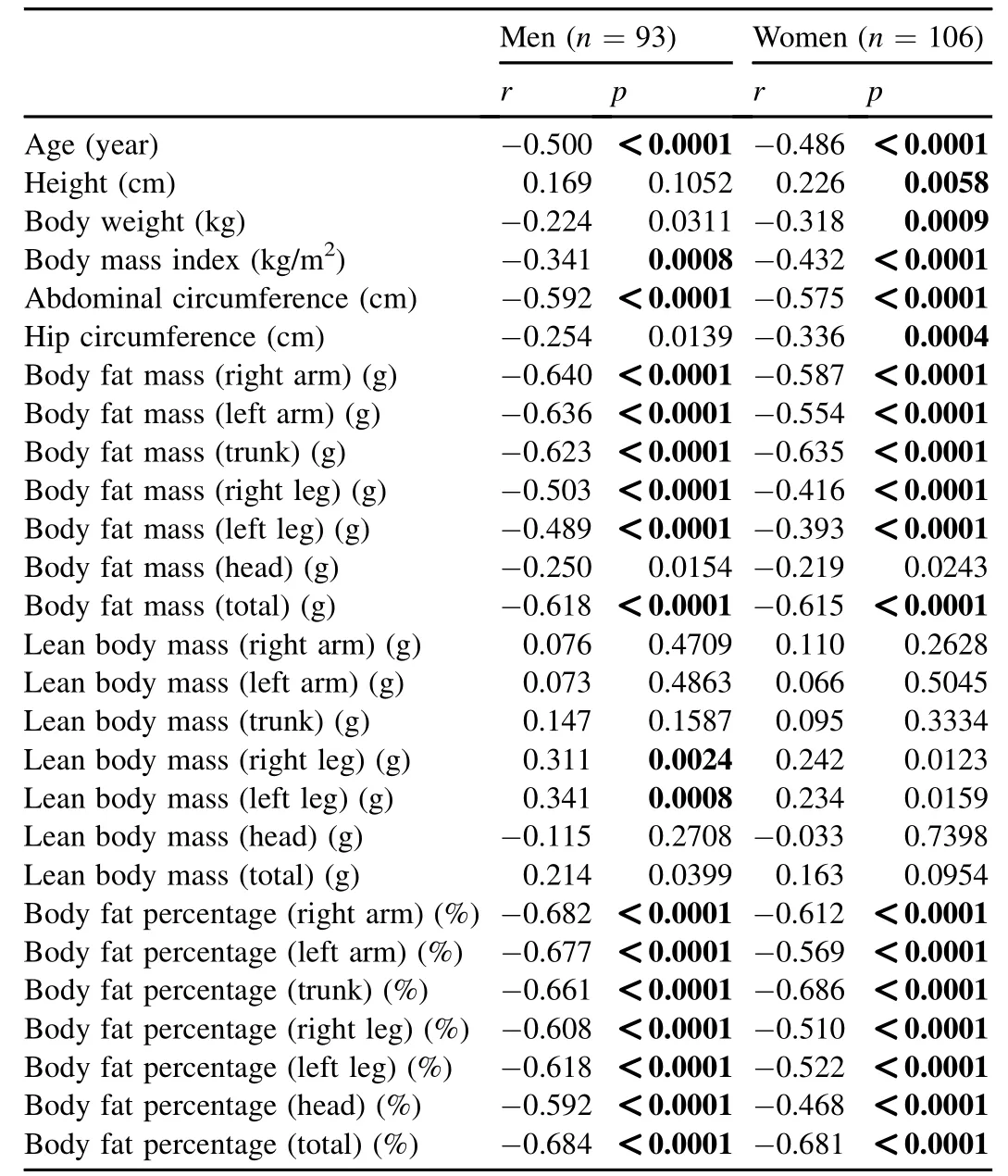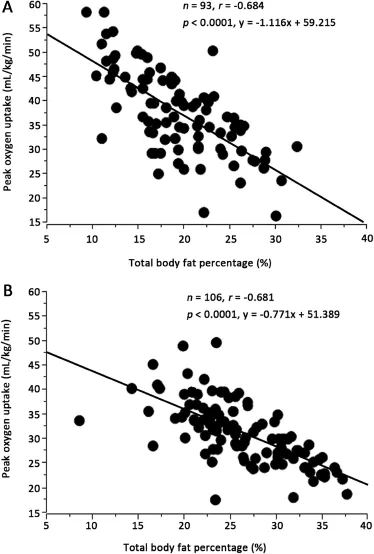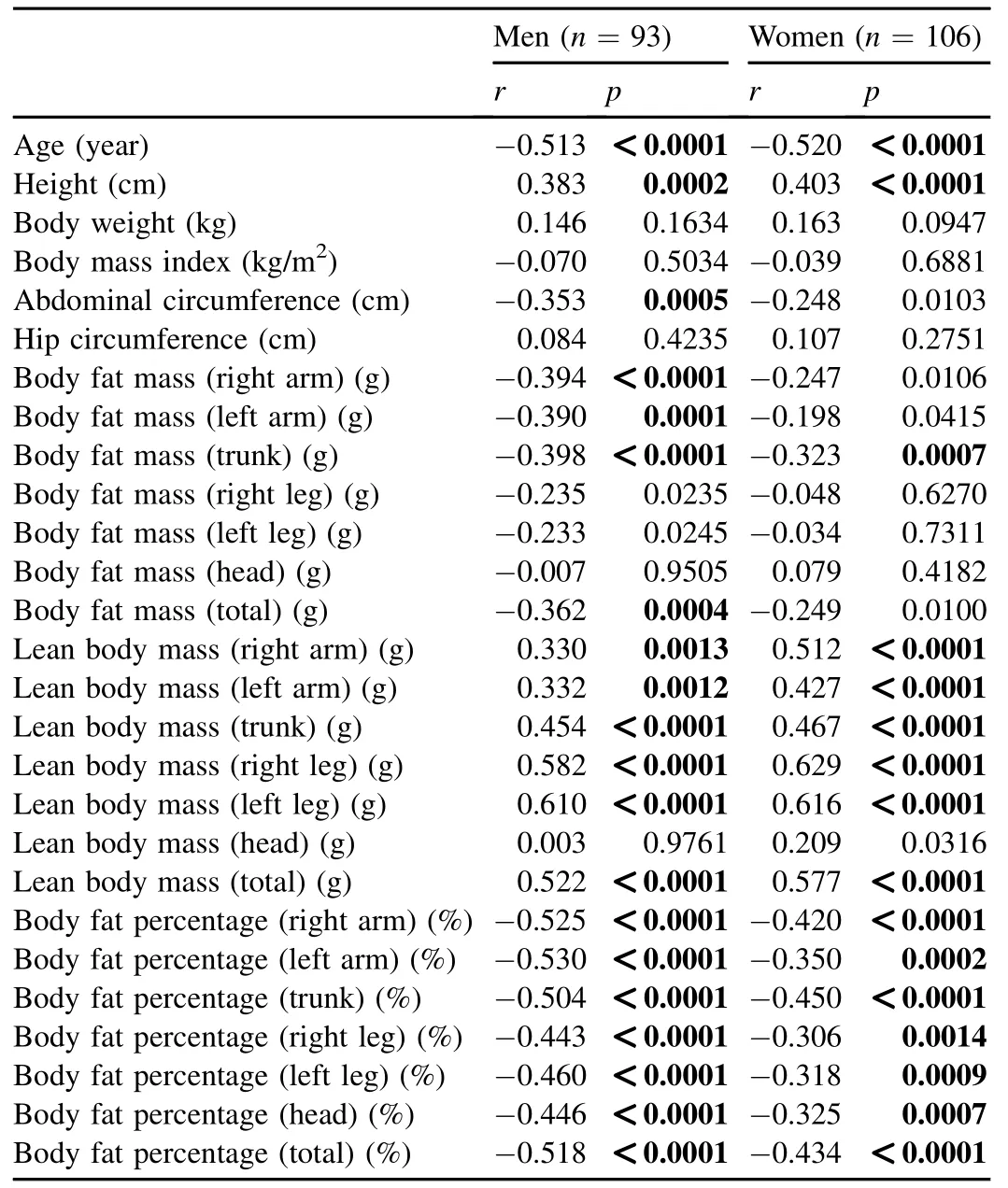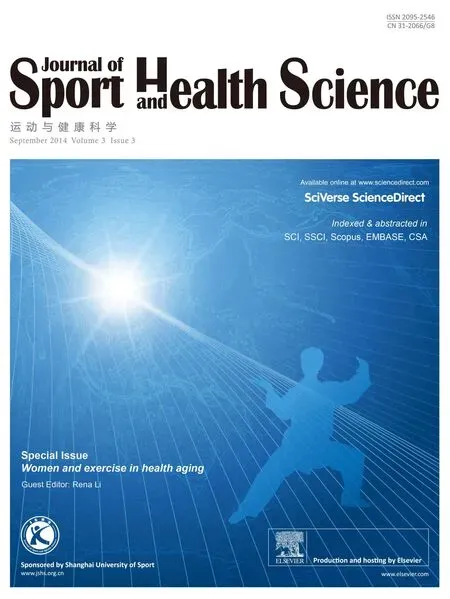Relationship between peak oxygen uptake and regional body composition in Japanese subjects
Kne O,Nouyuki M iytke,Noriko Skno,Tkeshi Sito,Motohiko M iyhi, Izum i Tt,Tkeyuki Numt
aDepartmentof Hygiene,Faculty of Medicine,Kagawa University,Kagawa 761-0793,Japan
bHealth Promotion and Exercise Program,National Institute of Health and Nutrition,Tokyo 162-8636,Japan
cFaculty of Sport and Health Science,Ritsumeikan University,Shiga 525-8577,Japan
dOkayama Southern Institute of Health,Okayama Health Foundation,Okayama 700-0952,Japan
Relationship between peak oxygen uptake and regional body composition in Japanese subjects
Kanae Odaa,*,Nobuyuki M iyatakea,Noriko Sakanoa,Takeshi Saitoa,Motohiko M iyachib, Izum i Tabatac,Takeyuki Numatad
aDepartmentof Hygiene,Faculty of Medicine,Kagawa University,Kagawa 761-0793,Japan
bHealth Promotion and Exercise Program,National Institute of Health and Nutrition,Tokyo 162-8636,Japan
cFaculty of Sport and Health Science,Ritsumeikan University,Shiga 525-8577,Japan
dOkayama Southern Institute of Health,Okayama Health Foundation,Okayama 700-0952,Japan
Purpose:To investigate the link between peak oxygen uptake and regionalbody composition by dual energy X-ray absorptiometry(DEXA)in Japanese subjects.
Methods:A totalof 93 men(42.2±12.3 years old)and 106 women(43.5±12.3 years old)were enrolled in this cross-sectional investigation study.Peak oxygen uptake was measured by the breath-by-breath method.Regional body composition i.e.,body fatmass,lean body mass,and body fat percentage was evaluated using DEXA.In addition,metabolic risk parameters were also evaluated.
Results:Peak oxygen uptake was 37.6±8.7 m L/kg/m in in men and 31.1±6.4 m L/kg/m in in women,and decreased w ith age in both genders. Peak oxygen uptake was significantly correlated w ith totalbody fatpercentage(men:r=-0.684,p<0.0001;women:r=-0.681,p<0.0001). These associations remained even after adjusting for age and total lean body mass.However,peak work rate was positively and significantly correlated w ith leg lean body mass.
Conclusion:Peak oxygen uptake was closely correlated w ith totalbody fatpercentage in both genders.Aerobic exercise as wellas leg resistance training m ight be useful for improving peak oxygen uptake in Japanese subjects.
CopyrightⒸ2014,Shanghai University of Sport.Production and hosting by Elsevier B.V.All rights reserved.
Dual energy X-ray absorptiometry(DEXA);Japanese;Leg muscle mass;Peak oxygen uptake;Regional body composition
1.Introduction
It is well-known that regular physical activity increases high density lipoprotein(HDL)cholesterol and reduces triglycerides,resting blood pressure,fasting blood sugar, abdominal fat accumulation,and insulin responses to an oral glucose challenge test.1—5Sandvik et al.6reported that physical fi tness was a graded,independent,long-term predictor of mortality from cardiovascular causes in healthy,m iddle-aged men.Sawada et al.7showed that low cardiorespiratory fi tness was associated w ith cancer mortality in Japanese men.7In addition,there are some studies demonstrating changes in aerobic exercise level w ith aging in Japanese subjects.8,9
Maximaloxygen uptake is generally considered an accurate and reliable parameter.In the Exercise and Physical Activity Reference for Health Promotion 2006,established by the M inistry of Health,Labour and Welfare of Japan in 2006, maximal oxygen uptake was considered to be the most significant element of physical fi tness related to healthpromotion,and the recommended reference value for maximal oxygen uptake to prevent lifestyle-related disease was reported.10
The ventilatory threshold(VT),which is defined as the upper lim it of aerobic exercise,is also thought to serve as a standard for exercise recommended reference value.11We have previously reported that the VTwas negatively correlated w ith total body fat percentage.12However,the link between peak oxygen uptake and regionalbody composition using dual energy X-ray absorptiometry(DEXA)still remains unknown. Therefore,in this study,we evaluated the relationship between peak oxygen uptake and regional body composition in Japanese subjects.
2.M ethods
2.1.Subjects
We enrolled 93 men(42.2±12.3 years old)and 106 women (43.5± 12.3 years old)who met the following criteria:(1) wanted to volunteer in this cross-sectional investigation study at Okayama Southern Institute of Health;(2)had received anthropometric and peak oxygen uptake measurements and body composition measurements by using DEXA;(3)received no medications fordiabetes,hypertension,and/ordyslipidem ia; and(4)provided w ritten informed consent(Table 1).
Ethical approval for the study was obtained from the Ethical Comm ittee of Okayama Health Foundation.
2.2.Anthropometric and body composition measurements
Anthropometric and body compositions were evaluated based on the follow ing parameters:height,body weight, abdom inal circum ference,hip circum ference,and body composition.The abdom inal circum ference was measured at the umbilicus,and the hip was measured at the w idest circum ference over the trochanters in standing subjects after a normal exhalation.13The body composition was measured by DEXA(QDR4500,Hologic Inc.,Waltham,MA,USA), which is accepted as an accurate standard.14The DEXA measurement consisted of a whole body scan using an arraybeam.15The subjects removed all metal objects,and were positioned in the supine position w ith their hands placed on either side of the body and their legs held 10 cm apart according to the specifications of the manufacturer.All scans were analyzed according to the manufacturer’s instructions.16Body fat mass,lean body mass,body fat percentage of the entire body and specific regions,i.e.,the right arm,left arm, trunk,right leg,left leg,and head,were manually and automatically calculated according to the instrument.

Table 1 Clinical characteristics of enrolled subjects.
2.3.Exercise testing
Peak oxygen uptake was measured using a maximalgraded exercise test w ith bicycle ergometers(Excalibur V2.0,Lode BV,Groningen,Netherlands).The initial work load was 30—60 w,and the work rate wasincreased thereafterby 15 w/min until the subject could not maintain the required pedaling frequency(60 rpm).17During the latter stages of the test,each subject was verbally encouraged by the test operators to give their maximal effort.In addition,an ECG was monitored continuously while recording the heart rate(HR).The expired gas was collected,and the rates of oxygen consumption(VO2) and carbon dioxide production(VCO2)were measured breathby-breath using a cardiopulmonary gas exchange system (Oxycon A lpha,M ijnhrdt B.V.,Netherlands).The achievementof peak oxygen uptake was accepted if the follow ing two conditions were met:the subject’s maximal HR was>95%of the age-predicted maximal HR(220—age),and the VO2curve showed a leveling off.In addition,the observed maximal work rate during the testing was used for this analysis.
2.4.Blood pressure(BP)measurements at rest
Resting systolic and diastolic BP(SBP and DBP)were measured indirectly using a mercury sphygmomanometer placed on the right arm of the seated participant after at least 15 min of rest.
2.5.Blood sampling and assays
A fterthe subjectsfasted overnightfor10—12 h,blood samples were collected in order to determine the levels of HDL cholesterol,triglycerides(L Type Wako Triglyceride H,Wako Chemical,Osaka,Japan),insulin and blood glucose.Serum insulin was measured by immunoradiometric assay(IRMA)using INSULIN RIABEAD(DAINABOT,Tokyo,Japan).Blood glucose was measured by the glucose-oxidantmethod.The insulin resistance was evaluated using the homeostasis model assessment,the Homeostasis modelassessment(HOMA)index(fasting plasma glucose(mg/dL)× fasting serum insulin(μU/m L)/405), according to the method developed by Matthews etal.18
2.6.Statistical analysis
All data are expressed as means±SD values.The sample sizes of all parameters were thought to be sufficient and had a normal distribution,and hence Pearson’s correlation coefficients were calculated and used to test the significance of the linear relationship between continuous parameters:wherep<0.05 was considered statistically significant.However,in the relationship between the peak oxygen uptake and regional body composition,and between the work rate and regional body composition,ap<0.007(0.05/7≈0.007)was considered statistically significant after the Bonferroni correction. Multiple regression analysis was also used to adjust for confounding factors,andp< 0.05 was considered statistically significant.
3.Results
The measurementsofparametersare summarized in Table 1. The peak oxygen uptake in enrolled subjects was 37.6±8.7 m L/kg/m in in men,and 31.1±6.4 m L/kg/m in in women.The total body fat percentage using DEXA was 19.4%±5.3%in men and 26.2%±5.7%in women(Table 1).
We investigated the age-related changes in peak oxygen uptake.The peak oxygen uptake was significantly and negatively correlated w ith age(men:r=-0.500,p< 0.0001; women:r=-0.486,p<0.0001).
The simple correlation analysis between peak oxygen uptake and anthropometric,body composition parameters using DEXA was evaluated(Table 2).In men,peak oxygen uptake was negatively correlated w ith abdom inalcircum ference,body fat mass(except for head fat mass)and body fat percentage.The correlation coefficient between peak oxygen uptake and total body fat percentage was the highest among the parameters tested(r=-0.684,p< 0.0001) (Fig.1A).In women,peak oxygen uptake was also negatively correlated w ith body mass index,abdominal circum ference, body fatmass(except for head),and body fatpercentage.The correlation coefficient between peak oxygen uptake and total body fat percentage was also the highest(r=-0.681,p<0.0001)among the parameters(Fig.1B).Next,we performed multiple regression analysis,and used peak oxygen uptake as dependent variable and age,total body fat percentage and total lean body mass as independent variables to adjust for confounding factors.The relationships between peak oxygen uptake and total body fat percentage were still significant even after adjusting for age and total lean body mass in both genders(standard correlation coefficients(β)of total body fat percentage (%)were -0.637 in men (p<0.0001)and-0.587 in women(p<0.0001)).

Table 2 Simple correlation analysis between peak oxygen uptake and body composition parameters.

Fig.1.Simple correlation analysis between peak oxygen uptake and totalbody fat percentage using DEXA in men(A)and women(B).

Table 3 Simple correlation analysis between work rate and body composition parameters.
We also investigated the relationship between the work rate and body composition parameters(Table 3).The work rate was positively correlated with lean body mass(trunk,right arm,left arm,right leg,left leg,and total)in men.The work rate was also negatively correlated w ith body fatpercentage in men.The correlation coefficientbetween the work rate and left leg lean body mass(r=0.610,p<0.0001)was the highest.In women,the work rate was positively correlated w ith height and lean body mass(except head).The work rate was negatively correlated w ith body fat percentage(right arm,trunk, and total).The correlation coefficient between work rate and right leg lean body mass(r=0.629,p<0.0001)was the highestamong the variables.
Finally,the peak oxygen uptake was weakly correlated w ith triglyceride levels(r=-0.393,p<0.0001),HDL cholesterol (r=0.227,p=0.0288),blood glucose(r=-0.317,p=0.0020),insulin(r=-0.231,p=0.0258),and the HOMA index(r=-0.249,p=0.0160)in men.In women, peak oxygen uptake was also weakly correlated with SBP (r=-0.281,p=0.0035),DBP(r=-0.198,p=0.0422), triglyceride(r= -0.357,p= 0.0002),blood glucose (r=-0.309,p=0.0013),insulin(r=-0.391,p<0.0001), and the HOMA index(r=-0.403,p<0.0001).
4.Discussion
Ohta et al.8reported that maximal oxygen uptake was significantly decreased with age in 832 apparently healthy subjects,and could be represented by the single regression line:y(maximal oxygen uptake:m L/kg/m in)=46.6-0.36×age (r=-0.447)in men andy=35.3-0.23×age(r=-0.407)in women.M iura9reported that oxygen uptake at VT was significantly correlated with age(men:r=-0.626,women:r=-0.578)in 610 Japanese subjects.The age-related decrease of the VTwasobserved in previousstudieson Japanese subjects not taking any medications.12In this study,the age-related decrease in peak oxygen uptake was also noted as per previous studies in Japanese subjects not taking any medications.The mean values obtained from this study also prom ise to be quite useful in reference databases for evaluating aerobic exercise levels defined by peak oxygen uptake in Japanese subjects.
In some literature,a relationship between aerobic exercise level and body composition has been reported.Watanabe etal.19reported thatmaximaloxygen uptake was significantly and negatively correlated with body fat percentage in a small sample of 21 boys and 16 girls.Sanada etal.20showed that the VT was significantly correlated w ith thigh skeletal muscle mass(men:r=0.58,women:r=0.47)in 1463 Japanese men and women.Yu et al.21also measured symptom-limited maximal oxygen uptake,and body composition using an impedance technique,and reported that physical activity was an important determ inant of the age-related decline in maximal oxygen uptake in Hong Kong Chinese.In patients w ith chronic heart failure,skeletal muscle mass was strongly predictive of maximal oxygen uptake at baseline and after exercise training.22In this study,peak oxygen uptake was significantly and negatively correlated w ith total body fat percentage using DEXA in apparently healthy Japanese men and women.In addition,peak oxygen uptake was weakly correlated w ith metabolic risk parameters.
We have previously proved the link between the VT and leg strength perbody weightin Japanese women in a cross-sectional study.23In a longitudinal study,an increase in leg strength per body weight was associated w ith improving metabolic syndrome and abdom inal circum ference in Japanese men.24It wasspeculated to be difficult forsubjectsw ith a smaller leg lean body mass to support the entire their body weight,and also difficult for those subjectsw ith less leg lean body mass to carry outaerobic exercise,i.e.,walking and jogging.In addition,peak oxygen uptake was also linked to totalbody fatpercentage.Itis well-known that fatisstored forenergy,whereasmuscle are the main engines thatuse energy.However,when aerobic exercise reached certain level,it starts to burn fat.Taken together, although aerobic exercise has been advocated as the most suitable activity for reducing body fatpercentage and increasing aerobic exercise levels,such as peak oxygen uptake,it is important for subjects w ith smaller leg lean body mass to maintain ormaximize the lean body mass of their lower limbs, as wellas to carry outaerobic exercise,to reduce fatmass and increase peak oxygen uptake,thus resulting in improved metabolic risk factors in Japanese subjects.
Potential limitations still remain in this study.First,our study was a cross-sectional but not a longitudinal study. Second,93 men and 106 women in our study voluntarily underwent measurements:they were therefore more likely to be health-conscious as compared w ith the average person. Third,we could notshow a clearmechanism between body fat percentage and peak oxygen uptake.However,it seems reasonable to suggest that promoting aerobic exercise as well as resistance training of the lower limb m ight result in improved peak oxygen uptake and metabolic risk factors in some Japanese subjects.To show this,further prospective and largersample size studies are urgently required in the Japanese population.
5.Conclusion
In this study,we accurately evaluated the relationship between peak oxygen uptake and regional body composition using DEXA in Japanese subjects for the fi rst time.The total body fat percentage was closely correlated to peak oxygen uptake,even after adjusting for confounding factors in both genders.In addition,work rate was positively correlated w ith lower lean body mass.
Acknow ledgm ent
This research was supported in part by Research Grants from the M inistry of Health,Labour,and Welfare of Japan.
1.Yamanouchi K,Shinozaki T,Chikada K,Nishikawa T,Ito K,Shim izu S, et al.Daily walking combined w ith diet therapy is a useful means for obese NIDDM patients notonly to reduce body weightbutalso to improve insulin sensitivity.Diabetes Care1995;18:775—8.
2.Oshida Y,Yamanouchi K,Hayam izu S,Sato Y.Long-term m ild jogging increases insulin action despite no influence on body mass index or VO2max.J Appl Physiol1989;66:2206—10.
3.M iyatake N,Takahashi K,Wada J,Nishikawa H,Morishita A,Suzuki H, et al.Daily exercise lowers blood pressure and reduces visceral fat in overweight Japanese men.Diabetes Res Clin Pract2003;62:149—57.
4.Barnard RJ,Ugianskis EJ,Martin DA,Inkeles SB.Role of diet and exercise in the management of hyperinsulinemia and associated atherosclerotic risk factors.Am J Cardiol1992;69:440—4.
5.M iyatake N,Nishikawa H,Morishita A,Kunitom i M,Wada J,Suzuki H, et al.Daily walking reduces visceral adipose tissue areas and improves insulin resistance in Japanese obese subjects.Diabetes Res Clin Pract2002;58:101—7.
6.Sandvik L,Erikssen J,Thaulow E,Erikssen G,Mundal R,Rodahl K. Physical fi tness as a predictor of mortality among healthy,m iddle-aged Norwegian men.N Engl J Med1993;328:533—7.
7.Sawada SS,Muto T,Tanaka H,Lee IM,Paffenbager Jr RS,Shindo M, et al.Cardiorespiratory fi tness and cancer mortality in Japanese men: a prospective study.Med Sci Sports Exerc2003;35:1546—50.
8.Ohta T,Zhang J,Ishikawa K,Tabata I,Yoshitake Y,M iyashita M.Peak oxygen uptake,ventilatory threshold and leg extension power in apparently healthy Japanese.Nihon Koshu EiseiZasshi1999;46:289—97[in Japanese].
9.M iura K.Ventilatory threshold in Japanese-as the basis for exercise prescription for: health promotion.NihonKoshuEiseiZasshi1996;43:220—30[in Japanese].
10.M inistry of Health,Labourand Welfare Japan.Exercise and physicalactivity reference for health promotion 2006.Available at:http://www.mhlw.go.jp/ bunya/kenkou/undou01/pdf/data.pdf;2007.p.9—10.[accessed 18.06.2012]. [in Japanese].
11.Wasserman K,Whipp BJ,Koyl SN,Beaver WL.Anaerobic threshold and respiratory gas exchange during exercise.J ApplPhysiol1973;35:236—43.
12.M iyatake N,M iyachi M,Tabata I,Sakano N,Suzue T,Hirao T,et al. Evaluation of ventilatory threshold and its relation to exercise habits among Japanese.Environ Health Prev Med2010;15:374—80.
13.Definition and the diagnostic standard for metabolic syndrome—Comm ittee to Evaluate Diagnostic Standards for Metabolic Syndrome.Nihon Naika Gakkai Zasshi2005;94:794—809[in Japanese].
14.Wang J,Heymsfield SB,Aulet M,Thornton JC,Pierson Jr RN.Body fat from body density:underwater weighingvs.dual-photon absorptiometry.Am J Physiol1989;256:E829—34.
15.Gustafsson L,Jacobson B,Kusoffsky L.X-ray spectrophotometry forbonm ineral determ inations.Med Biol Eng1974;12:113—9.
16.Herd RJ,Blake GM,Parker JC,Ryan PJ,Fogelman I.Total body studies in normal British women using dual energy X-ray absorptiometry.Br J Radiol1993;66:303—8.
17.M iyachi M,Tanaka H,Yamamoto K,Yoshioka A,Takahashi K, Onodera S.Effects of one-legged endurance training on femoral arterial and venous size in healthy humans.J Appl Physiol2001;90:2439—44.
18.Matthews DR,Hosker JP,Rudenski AS,Naylor BA,Treacher DF, Turner RC.Homeostasis model assessment:insulin resistance andβ-cell function from fasting plasma glucose and insulin concentrations in man.Diabetologia1985;28:412—9.
19.Watanabe K,Nakadomo F,Maeda K.Relationship between body composition and cardiorespiratory fi tness in Japanese junior high school body and girls.Ann Physiol Anthrop1994;13:167—74.
20.Sanada K,Kuchiki T,M iyachi M,M cGrath K,Higuchi M, Ebashi H.Effects of age on ventilator threshold and peak oxygen uptake normalized for regional skeletal muscle mass in Japanese men and women aged 20—80 years.EurJAppl Physiol2007;99:475—83.
21.Yu R,Yau F,Ho S,Woo J.Cardiorespiratory fi tness and its association w ith body composition and physical activity in Hong Kong Chinese women aged from 55 to 94 years.Maturitas2011;69:348—53.
22.LeMaitre JP,Harris S,Hannan J,Fox KA,Denvir MA.Maximum oxygen uptake correlated for skeletal muscle mass accurately predicts functional improvements following exercise training in chronic heart failure.Eur J Heat Fail2006;8:243—8.
23.M iyatake N,Takenami S,Kawasaki Y,Fujii M.Relationship between visceral fat accumulation and physical fi tness in Japanese women.Diabetes Res Clin Pract2004;64:173—9.
24.M iyatake N,M iyachi M,Numata T.Increasing leg strength per body weight is associated w ith improvements in metabolic syndrome in Japanese men.Anti-Aging Med2009;6:1—4.
Received 18 October 2012;revised 15 November 2012;accepted 29 November 2012
*Corresponding author.
E-mail address:oda@med.kagawa-u.ac.jp(K.Oda)
Peer review under responsibility of Shanghai University of Sport.
2095-2546/$-see front matter CopyrightⒸ2014,Shanghai University of Sport.Production and hosting by Elsevier B.V.A ll rights reserved. http://dx.doi.org/10.1016/j.jshs.2012.11.006
 Journal of Sport and Health Science2014年3期
Journal of Sport and Health Science2014年3期
- Journal of Sport and Health Science的其它文章
- Women’s health in exercise and aging:What do we know?
- Why women see differently from the way men see?A review of sex differences in cognition and sports
- Sex differences in exercise and drug addiction:A m ini review of animal studies
- Women and exercise in aging
- Effects of carbohydrate supplements on exercise-induced menstrual dysfunction and ovarian subcellular structural changes in rats
- Exercise training and antioxidant supplementation independently improve cognitive function in adult male and female GFAP-APOE m ice
